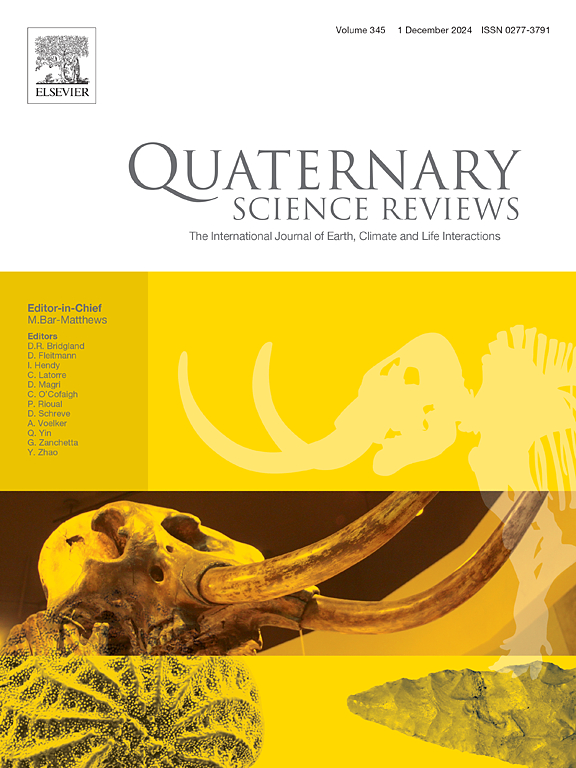Hydrological changes in the East Asian monsoon region around 4.2 ka precisely reconstructed from multi-proxy stalagmites
IF 3.2
1区 地球科学
Q1 GEOGRAPHY, PHYSICAL
引用次数: 0
Abstract
The 4.2 ka event was considered a climatic event that influenced ancient cultural transitions during the Middle-Late Holocene. However, whether this was a global climate event, remains controversial. Although some studies have discussed the changes in the Asian summer monsoon during the 4.2 ka event, the climate change patterns in the Yangtze River Basin (YRB) during this period remain unclear. In this study, we utilized multi-proxy (δ18O, δ13C, and Mg/Ca) records from stalagmite YK1306 to reconstruct the climatic changes in the YRB during 3000∼5000 yr BP. Based on comparative analysis of the high-resolution stalagmite records and other geological proxies within this region, the increased precipitation in the YRB during 4300∼4000 yr BP led to frequent flooding disasters, while double droughts occurred during 4000∼3700 yr BP and 4500∼4300 yr BP. Although there are differences in the characteristics of the 4.2 ka event recorded by speleothems across the Asian summer monsoon region, the 4.2 ka event indicated in the δ18O and δ13C records from speleothems in the YRB is inconsistent with the previously defined 4.2 ka event. The transition of El Niño-Southern Oscillation (ENSO) events resulted in the occurrence of flooding and droughts in the YRB during 4500∼3700 yr BP. This study not only provides new evidence of the hydrological changes in the YRB, but also helps evaluate the impact of climate change on civilizations in the YRB in the Late Neolithic.
多代石笋精确重建东亚季风区4.2 ka前后的水文变化
4.2 ka事件被认为是影响全新世中晚期古代文化变迁的气候事件。然而,这是否是一个全球性的气候事件,仍然存在争议。尽管一些研究讨论了4.2 ka事件期间亚洲夏季风的变化,但长江流域在此期间的气候变化模式尚不清楚。本研究利用YK1306石笋的δ18O、δ13C和Mg/Ca等多指标记录,重建了3000 ~ 5000年BP期间YK1306石笋的气候变化。通过对该地区高分辨率石笋记录和其他地质指标的对比分析发现,4300 ~ 4000年BP期间,长江三角洲降水增加导致洪涝灾害频发,而4000 ~ 3700年和4500 ~ 4300年BP期间则出现了双干旱。尽管整个亚洲夏季风区的岩洞记录的4.2 ka事件特征存在差异,但YRB岩洞的δ18O和δ13C记录显示的4.2 ka事件与先前定义的4.2 ka事件不一致。El Niño-Southern涛动(ENSO)事件的转变导致YRB在4500 ~ 3700年期间发生了洪水和干旱。该研究不仅为长江流域水文变化提供了新的证据,而且有助于评估新石器时代晚期气候变化对长江流域文明的影响。
本文章由计算机程序翻译,如有差异,请以英文原文为准。
求助全文
约1分钟内获得全文
求助全文
来源期刊

Quaternary Science Reviews
地学-地球科学综合
CiteScore
7.50
自引率
15.00%
发文量
388
审稿时长
3 months
期刊介绍:
Quaternary Science Reviews caters for all aspects of Quaternary science, and includes, for example, geology, geomorphology, geography, archaeology, soil science, palaeobotany, palaeontology, palaeoclimatology and the full range of applicable dating methods. The dividing line between what constitutes the review paper and one which contains new original data is not easy to establish, so QSR also publishes papers with new data especially if these perform a review function. All the Quaternary sciences are changing rapidly and subject to re-evaluation as the pace of discovery quickens; thus the diverse but comprehensive role of Quaternary Science Reviews keeps readers abreast of the wider issues relating to new developments in the field.
 求助内容:
求助内容: 应助结果提醒方式:
应助结果提醒方式:


